2022 TOYOTA HIGHLANDER interior lights
[x] Cancel search: interior lightsPage 3 of 568

3TABLE OF CONTENTS
1
2
3
4
5
6
7
8
9
10
Brake Hold .........................213
4-3. Operating the lights and wip- ers
Headlight switch ................. 216
Automatic High Beam ........ 219
Fog light switch .................. 222
Windshield wipers and washer ......................................... 222
Rear windshield wiper and washer ............................. 225
4-4. Refueling Opening the fuel tank cap .. 227
4-5. Using the driving support sys- tems
Toyota Safety Sense 2.5 +......................................... 229
PCS (Pre-Collision System) ......................................... 235
LTA (Lane Tracing Assist)... 246
Dynamic radar cruise control with full-speed range ........ 257
RSA (Road Sign Assist) ..... 269
Stop & Start system ........... 272
BSM (Blind Spot Monitor)... 278
Intuitive parking assist ........ 284
RCTA (Rear Cross Traffic Alert) function ............................ 293
PKSB (Parking Support Brake) ......................................... 300
Parking Support Brake function (static objects) .................. 307
Parking Support Brake function (rear-crossing vehicles).... 310
Driving mode select switch ......................................... 311
Multi-terrain Select ............. 312
Snow mode switch ............. 315
Downhill assist control system ......................................... 316
Driving assist systems........ 318
4-6. Driving tips Winter driving tips............... 324Utility vehicle precautions ..
327
5-1. Toyota multi-operation touch Toyota multi-operation touch......................................... 332
5-2. Using the air conditioning system and defogger
Front manual air conditioning system ............................. 334
Front automatic air conditioning system ............................. 339
Rear manual air conditioning system ............................. 352
Rear automatic air conditioning system ............................. 354
Heated steering wheel/seat heaters/seat ventilators.... 358
5-3. Using the interior lights Interior lights list ................. 361
5-4. Using the storage features List of storage features ...... 364
Luggage compartment features ......................................... 369
5-5. Using the other interior fea- tures
Other interior features ........ 37
3
Garage do or opener
...........385
6-1. Maintenance and care Cleaning and protecting the vehicle exterior................. 394
Cleaning and protecting the vehicle interior.................. 397
6-2. Maintenance Maintenance requirements......................................... 400
General maintenance......... 402
5Interior features
6Maintenance and care
Page 22 of 568

22Pictorial index
■Ceiling
Auxiliary box .................................................. .................... P.367
Conversation mirror .......................................................... P.384
Interior light
*1............................................................... ...... P.362
Personal lights
*1............................................................... .. P.362
Moon roof switches
*2......................................................... P.170
Panoramic moon roof switches
*2..................................... P.173
Vanity mirrors ................................................. .................... P.383
Sun visors..................................................... ...................... P.383
“SOS” button
*2............................................................... ...... P.65
Inside rear view mirror
*2.................................................... P.154
Digital Rearview Mirror
*2................................................... P.155
Garage door opener switches
*2........................................ P.385
*1: The illustration shows the fron t, but they are also equipped i n the rear.
*2: If equipped
Page 36 of 568

361-1. For safe use
Airbag sensor assembly
Your vehicle is equipped with ADVANCED AIRBAGS designed
based on the US motor vehicle safety standards (FMVSS208). The
airbag sensor assembly (ECU) cont rols airbag deployment based on
information obtained from the sensors etc. shown in the system
components diagram above. This in formation includes crash sever-
ity and occupant information. As the airbags deploy, a chemical
reaction in the inflators quickly fills the airbags with non-toxic gas to
help restrain the motion of the occupants.
■If the SRS airbags deploy
(inflate)
●Slight abrasions, burns, bruising
etc., may be sustained from SRS
airbags, due to the extremely high
speed deployment (inflation) by
hot gases.
●A loud noise and white powder will
be emitted.
●Parts of the airbag module (steer-
ing wheel hub, airbag cover and
inflator) as well as the front seats,
parts of the front and rear pillars,
and roof side rails, may be hot for
several minutes. T he airbag itself
may also be hot.
●The windshield may crack.
●All of the doors will be unlocked.
( P.118)
●The brakes and st op lights will be
controlled automatically. ( P.319)
●The interior lights will turn on auto-
matically. ( P.363)
●The emergency flashers will turn
on automatically. ( P.448)
●Fuel supply to the engine will be
stopped. (P.455)
●For Safety Connect subscribers, if
any of the followin g situations
occur, the system is designed to
send an emergency call to the
response center, notifying them of
the vehicle’s location (without
needing to push the “SOS” button)
and an agent will attempt to speak
with the occupants to ascertain the level of emergency and assis-
tance required. If the occupants
are unable to communicate, the
agent automatically treats the call
as an emergency and helps to dis-
patch the necessary emergency
services. (
P. 6 5 )
• An SRS airbag is deployed.
• A seat belt pretensioner is acti-
vated.
• The vehicle is involved in a severe
rear-end collision.
■SRS airbag deployment condi-
tions (SRS front airbags)
●The SRS front airbags will deploy
in the event of an impact that
exceeds the set threshold level
(the level of forc e corresponding
to an approximately 12 - 18 mph
[20 - 30 km/h] frontal collision with
a fixed wall that does not move or
deform).
However, this threshold velocity will
be considerably higher in the follow-
ing situations:
• If the vehicle strikes an object, such as a parked vehicle or sign
pole, which can move or deform
on impact
• If the vehicle is involved in an underride collision, such as a colli-
sion in which the front of the vehi-
cle “underrides”, or goes under,
the bed of a truck
●Depending on the type of collision,
it is possible that only the seat belt
pretensioners and SRS seat cush-
ion airbag will activate.
Page 331 of 568

331
5
5
Interior features
Interior features
.5-1. Toyota multi-operation touch
Toyota multi-operation touch .................................. 332
5-2. Using the air conditioning system and defogger
Front manual air condition- ing system ................. 334
Front automatic air condi- tioning system ........... 339
Rear manual air condition- ing system ................. 352
Rear automatic air condi- tioning system ........... 354
Heated steering wheel/seat heaters/seat ventilators
.................................. 358
5-3. Using the interior lights Interior lights list .......... 361
5-4. Using the storage features List of storage features.................................. 364
Luggage compartment fea- tures .......................... 369
5-5. Using the other interior features
Other interior features . 373
Garage door opener.... 385
Page 359 of 568

3595-2. Using the air conditioning system and defogger
5
Interior features
Vehicle with a 12.3-inch dis-
play
Vehicle with a 8-inch display
■Front (Toyota multi-opera-
tion touch: Vehicle with a
12.3-inch display)
Select to display the seats
climate screen.
Each time the switch is selected,
the operation condition changes
as follows.
Hi (3 segments lit) Mid (2 seg-
ments lit) Lo (1 segment
lit) Off
The level indicator (red) lights
up during operation.
■Rear
Each time the switch is pressed,
the operation condition changes
as follows.
Hi (3 segments lit) Mid (2 seg-
ments lit) Lo (1 segment
lit) Off
The level indicator (amber)
lights up during operation.
■Operation condition
The engine switch is in ON.
WARNING
■To prevent overheating and
minor burn injuries
Observe the following precautions
when using the seat heaters.
●Do not cover the seat with a
blanket or cushion when using
the seat heater.
Page 361 of 568

3615-3. Using the interior lights
5
Interior features
5-3.Using the interior lights
Front personal lights (P.362)
Front interior lights ( P.362)
Shift lever light
Open tray lights (if equipped)
Door courtesy lights
Ambient lights (if equipped)
Rear personal lights (if equipped) ( P.362)
Rear personal lights (if equipped) ( P.362)
Rear interior light ( P.362)
Outer foot lights (if equipped)
Interior lights list
Location of the i nterior lights
Page 362 of 568

3625-3. Using the interior lights
■Front interior lights
1 Turns the lights on/off linked
to door positions
2 Turns the lights on
3 Turns the lights off
■Rear interior lights
1 Turns the door position on
The rear interior light turns on/off
together the front interior lights.
When a door is opened while the
front and rear interior light door
position is on, the lights turn on.
2Turns the light on
■Front personal lights
Turns the lights on/off
■Rear personal lights
Turns the lights on/off
Vehicles without panoramic
moon roof
Vehicles with panoramic
moon roof
■Illuminated entry system
The lights automatically turn on/off
according to the engine switch
mode, the presence of the elec-
tronic key, whether the doors are
locked/unlocked, and whether the
doors are opened/closed.
Operating the interior
lights
Operating the personal
lights
Page 363 of 568

3635-3. Using the interior lights
5
Interior features
■To prevent the battery from
being discharged
If the interior lights remain on when
the engine switch is turned off, the
lights will go off automatically after
20 minutes.
■The interior lights may turn on
automatically when
If any of the SRS airbags deploy
(inflate) or in the event of a strong
rear impact, the interior lights will
turn on automatically.
The interior lights will turn off auto-
matically after approximately 20
minutes.
The interior lights can be turned off
manually. However, in order to help
prevent further collisions, it is rec-
ommended that they be left on until
safety can be ensured.
(The interior lights may not turn on
automatically depending on the
force of the impact and conditions of
the collision.)
■Customization
Some functions can be customized.
( P.521)
NOTICE
■To prevent battery discharge
Do not leave the lights on longer
than necessary when the engine
is not running.